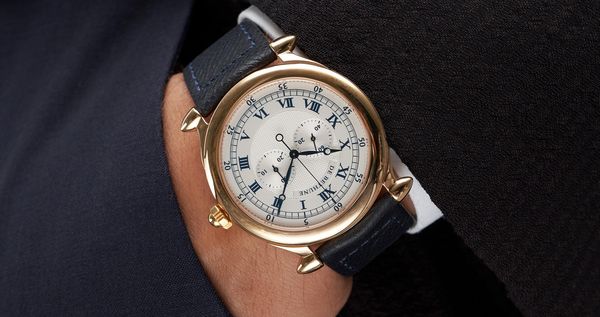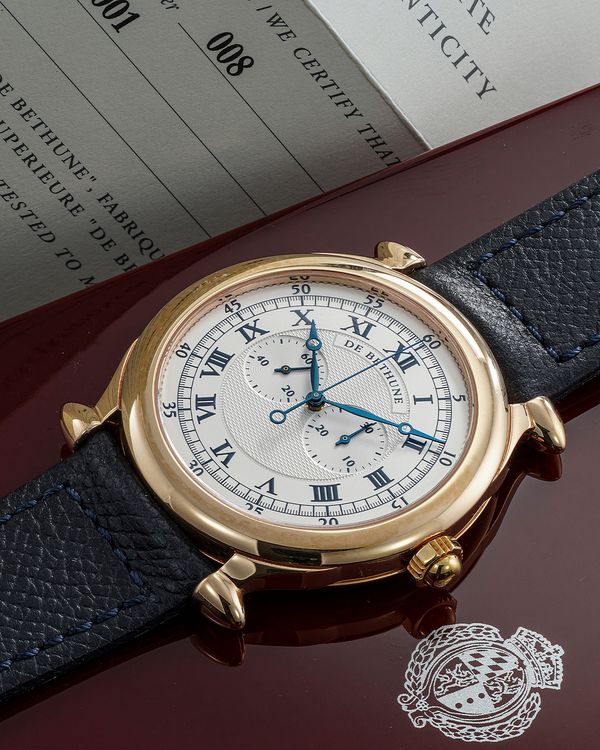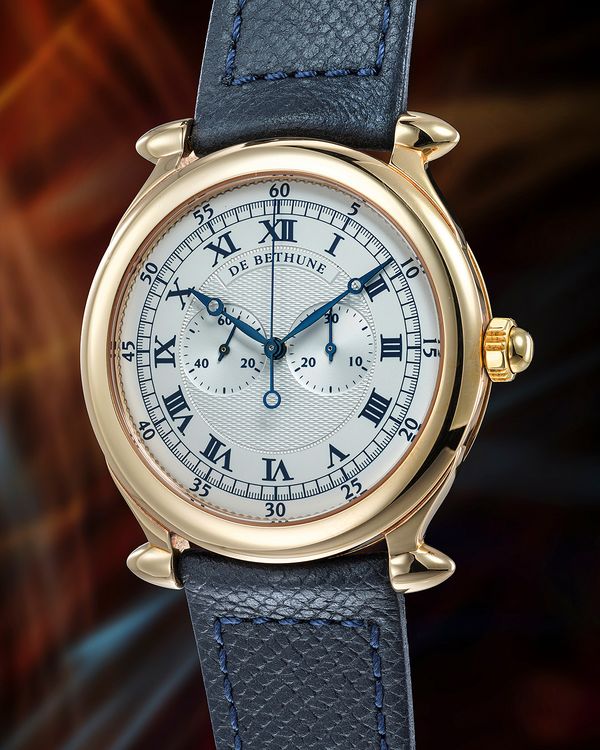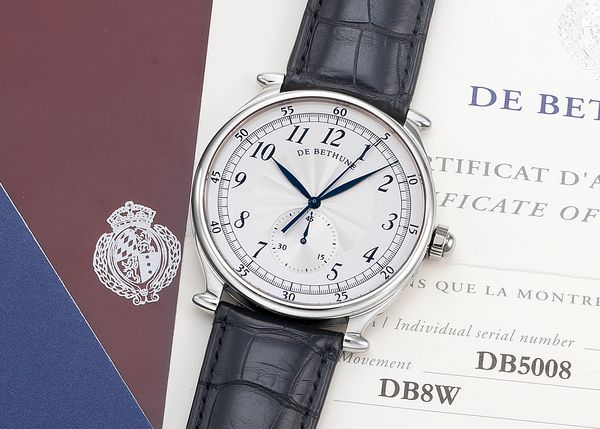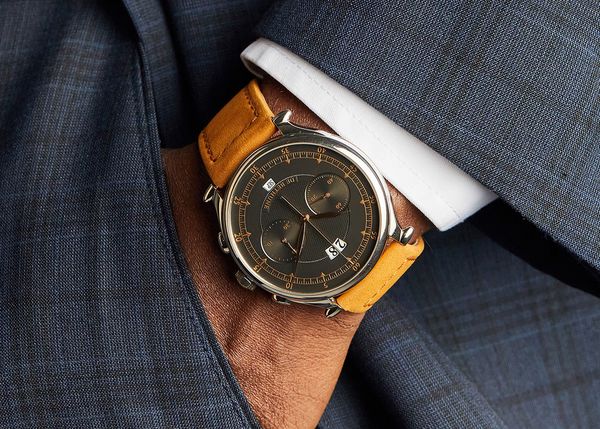Our first live auction of the fall 2023 season, the PHILLIPS Geneva Watch Auction: XVIII, takes place on November 3 and 4, at La Réserve Genève. The auction includes more than 180 of the world's finest watches – and though we are loath to boast, we truly think it's one of the best catalogs we've ever put together. We'll be highlighting a number of the most interesting lots and stories featured in the sale over the next month, including the De Bethune DB1 Chronograph featured in this story.
– Logan Baker
What's the first thing you think of when it comes to De Bethune?
Probably something involving the brand’s famous space-age aesthetics, right? Something along the lines of floating lugs, three-dimensional moon-phases, and ample use of heat-treated titanium, maybe? Or perhaps you’ll think of De Bethune’s relentless dedication to innovation in watchmaking, an attribute that has led it to develop more than 30 in-house movements during its short life?
And if you were to come up with one or two specific watches that best represent those qualities, you’d probably think of a watch like the DB25 Starry Varius, the DB27 Titan Hawk, or one of the many, many variations of the flagship DB28 series.
De Bethune has built one of the best reputations in the world of independent watchmaking around those accolades. It creates watches that both look and work unlike anything else on the market. It’s a fascinating part of the collecting landscape that continues to attract more and more collectors with each passing year.
Interestingly enough, there’s one section of the De Bethune brand that has remained relatively under-the-radar of most collectors. The watches from De Bethune’s first few years of production are some of the least desired. But it shouldn’t be that way. The Swiss brand’s so-called “Founding Collection” is full of fascinating watches produced when the company was still trying to find its identity. These watches come before many of De Bethune’s flagship features were introduced. The typically feature precious metal cases with unusual bullet-shaped lugs (called “ogival”-style lugs by De Bethune), reworked ébauche calibers, and traditional dress-leaning aesthetics.
Within De Bethune’s early years, perhaps the most interesting work can be found in a run of three different chronograph references introduced during the brand’s first two years of production. Unlike the extraordinary, GPHG-winning Maxichrono – which would help take De Bethune to the next level after its 2006 introduction – the DB1, DB8, and DB12 chronographs didn’t quite reinvent the wheel. But they did help establish the De Bethune brand, and provided a successful template that De Bethune would continue to build on in the years to come.
2002: De Bethune DB1 Single-Button Chronograph
De Bethune's very first horological creation, the DB1, was introduced to the world in 2002. It was a monopusher chronograph offered in a 42mm × 8mm case with ogival-shaped lugs in 18k white gold (28 pieces) and 18k yellow gold (21 pieces).
The DB1 has a far more traditional aesthetic than what is typically associated with De Bethune today. The flat polished precious-metal bezel surrounds a silver dial with a grain d'orge (barley grain) guilloché center, two sub-dials, Roman hour numerals, and Arabic five-minute markers on the outskirts of the dial. Simple blued Breguet hands keep track of the passing hours and minutes.
The movement used inside De Bethune’s first watch is hidden behind a closed caseback. The manual-wind caliber inside also wasn’t a brand-new design. De Bethune’s founding watchmaker, Denis Flageollet, borrowed the architecture of the monopoussoir chronograph caliber 045MC he had developed while running Techniques Horlogères Appliquées (THA), in Sainte-Croix, alongside François‐Paul Journe and Vianney Halter, for the ‘90s classic Cartier Monopoussoir CPCP ref. 2396B.
Our own Arthur Touchot spoke with Flageollet a few years ago about the development of the caliber 045MC. “The movement is relatively simple, it didn’t pose any particular problems, it just took a little time to adapt to achieving the calibers that corresponded to Cartier’s watchmaking standards,” Flageollet said. “The biggest difficulty was to get Cartier's technicians to understand that they had to have less security on the casing to match the spirit of the original watch and avoid creating a monster!”
One special attribute of the caliber 045MC was a unique clutch system that incorporated an additional swivel pin, which removes the awkward jump of the central seconds hand when activating the chronograph mechanism. The movement, on the DB1, is stamped “CDB,” which stands for Chevalier de Bethune, the 18th-century French aristocrat and horologist the brand is named after. The movement used in the DB1 has a higher quality of finish than the original Cartier version, featuring ample hand polishing. Flageollet and De Bethune would revisit the caliber 045MC architecture once again in 2003, with the DB8.
Despite its status as the inaugural De Bethune watch, the DB1 remains fairly underrated by collectors. It’s also remarkably rare, with only 50 known examples across all three case metals. In fact, it’s so rare that the example included in our upcoming Geneva Watch Auction: XVIII (lot 103) is the first to appear at Phillips. It has case serial number 8 out of the 21 pieces produced in 18k pink gold. It has an estimate of CHF 20,000 – 40,000.
2003: De Bethune DB8 Single-Button Chronograph 'Football Timer'
De Bethune introduced its second take on a monopusher chronograph the following year, in 2003. The DB8 looked very similar to the DB1 with one major change – the dial no longer featured two sub-dials. In its place, a single register was positioned above six o’clock. If you didn’t know what you were looking at, it would be incredibly easy to dismiss the DB8 as a standard time-only watch.
In actuality, the six o’clock sub-dial serves as a 45-minute counter for the chronograph rather than a small seconds. The watch has running hours and minutes, plus central chronograph seconds and the 45-minute counter. This is a similar formula to what De Bethune used earlier this year, in 2023, on the new-generation DB Eight single-button chronograph – running hours and minutes, central chronograph seconds, and a 60-minute counter at six o’clock.
The DB8 from 2003, meanwhile, is sometimes called the “Football Timer” by De Bethune collectors for the ability to use the 45-minute sub-dial to track elapsed time during halves of a football/soccer match. It was offered in four different case metals, including 18k yellow, white, and pink gold, as well as platinum, all in a 41.5mm × 8mm case shape with the recognizable ogival-shaped lugs and closed caseback.
The movement inside is, once again, a variation of the caliber 045MC that's been tweaked and streamlined to incorporate the six o’clock 45-minute register rather than the twin sub-dials (60-minute counter and running seconds) found on the DB1. The chronograph pusher remains inside the crown at three o’clock.
De Bethune offered the DB8 in a number of configurations, but the specific design choices were overall much more modern than what was found on the DB1. Breguet hands were removed in favor of a slim feuille-shaped handset, and all Roman numerals were dropped off the dials. The guilloché pattern in the center of the dial is now in a pulsating floral shape.
The DB8 was a foundational release for De Bethune in its second year of existence, and in my opinion is one of most compelling early watches from the brand. It’s a thoughtful evolution of the DB1 design that takes a signature complication and buries the lede. The fact that it’s a chronograph that doesn’t look like a chronograph – even the 8mm case thinness feels like it’s too small to be a chronograph! – makes it a fascinating concept and illustrative of the brand’s brilliance in watchmaking and design.
It’s no surprise De Bethune returned to this recipe with the DB Eight this year.
The DB8 is typically more sought-after than the DB1. Two examples have previously appeared at Phillips. A circa 2008 example in 18k white gold with silver dial that sold at Phillips Hong Kong for HKD $630,000, in November 2022, and a circa 2005 example with serial “000” in 18k white gold with a dark grey dial that was confirmed by the brand to be a prototype; it sold for USD $139,700 at Phillips New York, in June 2023.
2003: De Bethune DB12 Chronograph
The third and final chronograph released in De Bethune’s first two years of production is the DB12. It was the first De Bethune chronograph to not be a monopusher, instead opting for a traditional twin-pusher configuration on the caseband.
The DB12 sees De Bethune return to a dual sub-dial orientation, with two large registers at three (30-minute counter) and nine (running seconds) o’clock. Those displays are joined by a pair of calendar indications – a two-window big date at 12 o’clock, and a small aperture at six o’clock revealing the first three letters of the current month.
The movement, as you might expect, is no longer based on Flageollet’s previous THA design, but instead is built around the architecture of a Venus 175, a historic manual-wind caliber that originated in the 1940s. This movement is visible through an exhibition caseback for the first time on a De Bethune chronograph, revealing the intricate steel architecture with côtes de Genève-decorated bridges, polished chamfers, and a hairspring with Breguet overcoil and a swan-neck regulator.
The DB12 has a thicker case than its two single-button predecessors, measuring 42mm × 13mm, in 18k white or pink gold. It would be the last De Bethune chronograph to feature the ogival lugs until this year’s DB Eight revival. The solid-gold dial orientation offered the simplified legibility of the DB8 (feuille hands and no Roman numerals) with the twin sub-dials and central grain d'orge guilloché decoration of the DB1, plus extra information via the pair of calendar complications.
What is perhaps most interesting about the DB12 is its status as a transitionary reference for De Bethune. If the DB1 exists as the inaugural De Bethune, and the DB8 as an early experiment in simplified complications for the brand, then the DB12 is illustrative of a brand still trying to toe the aesthetic line between traditional high Swiss watchmaking and the high-octane, space-age designs it would later become known for.
It’s a thread that continues the following year, in 2004, with the release of the DB15, a perpetual calendar wristwatch that would introduce a new brand signature: the three-dimensional moon-phase display. The DBS and DBL, from 2005, would firmly push the brand forward into the avant-garde territory it continues to exist in today.
Only two DB12 examples have previously appeared at Phillips. A five-piece limited edition in 18k white gold with a dark grey dial was produced exclusively for customers of Chicago’s Swiss Fine Timing retailer in circa 2005; number five of that series sold for USD $138,600 at Phillips New York, in December 2021. A circa 2004 DB12 in 18k pink gold with a silver-tone dial later sold at Phillips New York for $82,550, in June 2023.
You can learn more, place a bid, and view the entire Geneva Watch Auction: XVIII catalog here.
About Phillips In Association With Bacs & Russo
The team of specialists at PHILLIPS Watches is dedicated to an uncompromised approach to quality, transparency, and client service. Phillips in Association with Bacs & Russo holds the world record for the most successful watch auction, with its Geneva Watch Auction: XIV having realized $74.5 million in 2021. Over the course of 2021 and 2022, the company sold 100% of the watches offered, a first in the industry, resulting in the highest annual total in history across all the auction houses at $227 million.
About Logan Baker
Logan has spent the past decade reporting on every aspect of the watch business. He joined Phillips in Association with Bacs & Russo at the start of 2023 as the department's Senior Editorial Manager. He splits his time between New York and Geneva.
Recommended Reading
Specialists' Picks: The Geneva Watch Auction: XVIII
13 Incredible Vintage Chronographs Featured In The Geneva Watch Auction: XVIII
